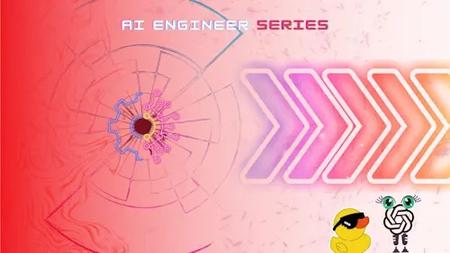English | MP4 | AVC 1920×1080 | AAC 44KHz 2ch | 150 Lessons (17h 53m) | 4.76 GB
Thrive in the AI era with this hands-on course that teaches you to build better AI applications using one of the most important AI techniques used in the real-world to supplement an AI model’s knowledge with proprietary or new information: Retrieval Augmented Generation (RAG).
Learn to make smarter AI systems by combining LLMs with Retrieval-Augmented Generation (RAG). Build real-world projects using RAG architecture including chatbots, financial analysis tools, and much more!
What you’ll learn
- Combine generative AI models with Retrieval Augmented Generation to build smarter AI systems
- Use OpenAI APIs for text generation and processing unstructured data
- Master FAISS for efficient similarity searches in massive datasets
- Apply prompt engineering techniques for optimal AI responses
- Build real-world AI projects like chatbots and financial analysis tools
- Explore advanced RAG concepts like multimodal and agentic RAG
Table of Contents
1 Course Outline
2 Meet Rubber Ducky! Your AI Course Assistant using RAG
3 Overview: Fundamentals of Retrieval Systems
4 Overview of Information Retrieval
5 What is Tokenization?
6 OpenAI Tokenizer
7 Libraries and Data Handling for RAG
8 Tokenization Techniques
9 Preprocessing Steps
10 Types of Retrieval Systems
11 Vector Space Model (TF-IDF)
12 Implementing TF-IDF
13 TF-IDF Function and Output Analysis
14 Boolean Retrieval Model
15 Boolean Retrieval Implementation
16 Probabilistic Retrieval Model – Part 1
17 Probabilistic Retrieval Model – Part 2
18 How Google Search Works
19 Key Concepts: Indexing, Querying, and Ranking
20 What Did You Learn in This Section?
21 ReAct Prompt Engineering
22 Chain of Thought Prompt Engineering
23 Overview: Generative AI Fundamentals
24 Introduction to Text Generation
25 Understanding Transformers
26 Rock-Paper-Scissors, Dices and Strawberries
27 Text Generation with GPT2
28 Tokenization for Text Generation
29 Padding the Data for Consistency
30 Attention Mechanisms
31 Creating a Dataset Class
32 Fine-Tuning the GPT-2 Model
33 Generating Text with GPT-2
34 What Did You Learn in This Section?
35 LLMs, Few-shot, Scaling and Factuality
36 Overview: RAG Fundamentals
37 Introduction to RAG Architecture
38 Tokenization and Embeddings for RAG
39 FAISS Index: Efficient Similarity Search
40 Building a Retrieval System
41 Developing a Generative Model
42 Implementing the RAG System
43 Defining a Relevant Context Distance
44 Understanding Generation Model Parameters
45 Configuring RAG with Parameters
46 What Did You Learn in this Section?
47 LongRAG and LightRAG
48 Overview: Working with the OpenAI API
49 OpenAI API for Text
50 Setting Up OpenAI API Key
51 System Message and Parameters
52 OpenAI API Setup
53 Generating Text with OpenAI API
54 OpenAI API Parameters
55 OpenAI API for Images
56 With Image URL
57 Converting Images to Base64
58 Assess My Python Course Thumbnail
59 What Did You Learn in this Section?
60 Project Briefing: Customer Acquisition
61 OpenAI Setup
62 AI Agent System Prompt
63 Processing Images for GenAI
64 Extract Data with GenAI
65 Improving GenAI Extraction
66 GenAI with all Images
67 PDF to Images
68 Wrapping Up the OpenAI GenAI Project
69 Overview: RAG with OpenAI GPT Models
70 Case Study Briefing: Cooking Books
71 Converting PDF to Images
72 Reading a Single Image with GPT
73 Enhancing AI with Prompt Engineering
74 Reading All Images in a Dataset
75 Filtering Non-relevant Information
76 Understanding Embeddings in NLP
77 Generating Embeddings
78 Building FAISS Index and Metadata Integration
79 Implementing a Robust Retrieval System
80 Combining Outputs for Enhanced Results
81 Constructing a Generative Model
82 Complete RAG System Implementation
83 How to Improve RAG Systems Effectively?
84 Overview: Working With Unstructured Data
85 Introduction to Langchain Library
86 Excel Data: Best Practices for Data Handling
87 Python – Initial Setup for Data Processing
88 Loading Data and Implementing Chunking Strategies
89 Developing a Retrieval System for Unstructured Data
90 Building a Generation System for Dynamic Content
91 Building Retrieval and Generation Functions
92 Working with Word Documents
93 Setting Up Word Documents for RAG
94 Implementing RAG for Word Documents
95 Working with PowerPoint Presentations
96 PowerPoint Setup for RAG
97 RAG Implementation for PowerPoint
98 Working with EPUB Files
99 EPUB Setup for RAG
100 RAG Implementation for EPUB Files
101 Working with PDF Files
102 PDF Setup for RAG
103 RAG Implementation for PDF Files
104 What Did You Learn in This Section?
105 Exercise: Imposter Syndrome
106 Overview: Multimodal RAG
107 Introduction to Multimodal RAG
108 Setup and Video Processing
109 Extracting Audio from Video
110 Compressing Audio Files
111 Transcribing Audio with OpenAI Whisper
112 Whisper Model
113 Extracting Frames from Video
114 Introduction to Contrastive Learning
115 Understanding the CLIP Model
116 Tokenizing Text for Multimodal Tasks
117 Chunking and Embedding Text
118 Embedding Images for Multimodal Analysis
119 Understanding Cosine Similarity in Multimodal Contexts
120 Applying Contrastive Learning and Cosine Similarity
121 Visualizing Text and Image Embeddings
122 Query Embedding Techniques
123 Calculating Cosine Similarity for Query and Text
124 GenAI Model Setup for Multimodal Tasks
125 Building a GenAI Model
126 What Did You Learn in This Section?
127 Project Briefing: Starbucks Financial Data
128 Transcribing Audio with OpenAI Whisper
129 Embedding Transcription with CLIP
130 Converting PDF to Images
131 Embedding Images for Multimodal Analysis
132 Retrieval System
133 Preparing Context
134 Generative System
135 Overview: Agentic RAG
136 AI Agents
137 Agentic RAG
138 Setup and Data Loading
139 State Management and Memory in Agentic Systems
140 AgentState Class
141 Greeting the Customer
142 AI Agent that Checks the Question
143 AI Agent that Assesses the Validity of the question
144 Retrieving the Documents
145 Testing the App
146 Generate Answers
147 AI Agent that Improves the Answer
148 Asking User For More Questions
149 Agentic RAG Recap – Key Learnings and Next Steps
150 Thank You!
Resolve the captcha to access the links!
